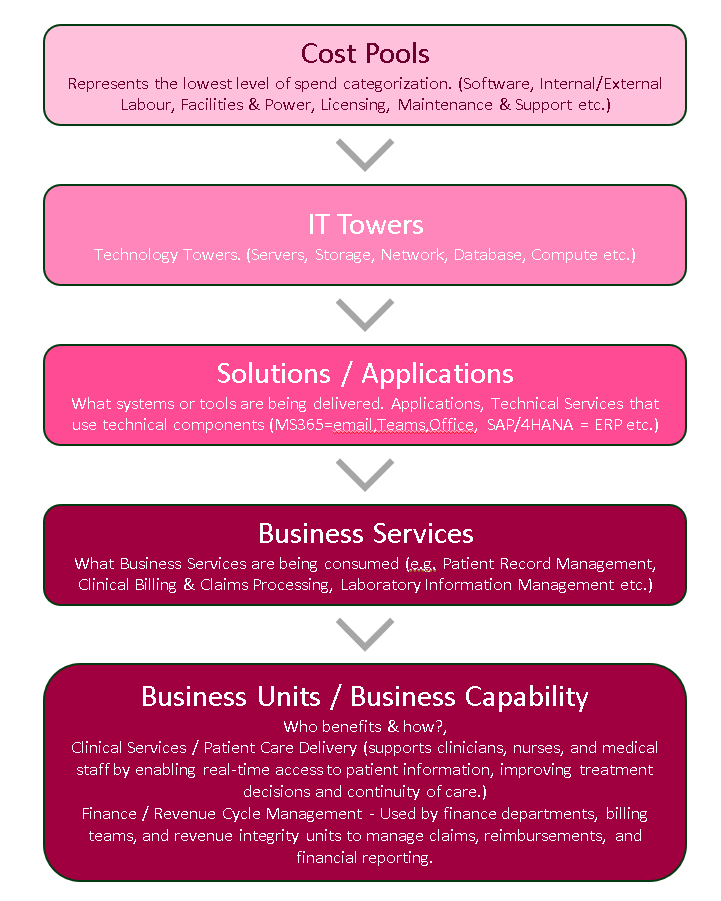Is your organisation struggling to explain IT costs to the business?
If IT, Finance, and business leaders can’t speak the same language about spend, conversations quickly become defensive and trust erodes. This is especially true in large enterprises with budgets in the hundreds of millions, where even small percentage changes mean millions of dollars at stake.
This article explores five common “trust us” conversations that happen when there’s no shared Service taxonomy, cost transparency, or linkage to business value. If you’ve ever faced questions you couldn’t answer in business terms or received answers that left you none the wiser, these examples will feel familiar.
By the end, you’ll see how TBM changes the discussion from vague justifications to clear, data-driven insights that connect every dollar spent to a business outcome.
I’m going to cross this based on my experience. In a $480 million IT budget, even small percentage changes mean millions of dollars. Yet in many organisations, conversations about IT spend are still vague, reactive, and disconnected from business outcomes.
Below are five real-world examples of what happens when cost transparency is missing, including industry specific cases from mining and healthcare. For each, we’ll look at why it happens and how TBM changes the conversation.
Do any of these sound familiar?
Budget Increase Without Context
The conversation today
Business Owner “My IT bill is up 25% this year, but my headcount hasn’t changed. Why?”
IT Response “Costs have gone up across the board, trust us, we’re managing it, we know what we are doing.”
The problem
This is a textbook absence of IT cost transparency. Without any underlying mapping of costs to business services (e.g., Payroll Processing, Customer Relationship Management, Supply Chain Planning), IT can only give generic answers.
How TBM changes it
By categorising IT spend from your cost pools what you paid for (e.g., Hardware, Software, External/Internal labour etc) and linking them to IT towers (e.g., Compute, Storage, Network, End User) and ultimately up-to business capability/service(e.g., Online Ordering Platform, Field Workforce Management, Claims Processing), TBM allows IT to show exactly what changes and where are driving the increase, whether it’s higher cloud consumption, licence renewals, or security enhancements and how it supports business outcomes.

Licence Expansion Without Usage Insight
The conversation today
Business Owner “Why did our software licence costs double? We didn’t add more staff.”
IT Response “We upgraded to a bigger package and it’s better value in the long run.”
The problem
The discussion is framed only as a procurement deal. Without consumption-based cost allocation or mapping to business services, there’s no proof the bigger package is actually used or needed.
How TBM changes it
TBM introduces showback and chargeback models, linking licence costs to actual usage by IT towers and business services so the business can see the cost per user or per service and make informed renewal decisions.
Infrastructure Spend Without Business Link (Mining Industry)
The conversation today
Operations Manager “You’ve charged us for part of a $10M network upgrade. What’s the impact for my mine sites?”
IT Response “It’s part of the enterprise refresh. All sites get more bandwidth.”
The problem
“More bandwidth” is a technical answer with no link to operational impact.
How TBM changes it
By mapping network costs in IT towers, to business services, TBM reframes the spend in terms of reduced downtime, faster geological data transfer, and improved safety system responsiveness, clear business outcome alignment.
Platform Upgrade Without Measurable Outcomes (Healthcare Industry)
The conversation today
Clinical Director “We’ve been billed for a new patient records platform. What’s changed for our clinics?”
IT Response “It’s more modern and compliant with regulations.”
The problem
The benefits are described in compliance and technology terms, without connecting to patient care or clinic efficiency.
How TBM changes it
With business services mapping (e.g., Patient Records Management, Clinical Workflow Management, Appointment Scheduling) tied to IT towers (e.g., Applications, Data & Analytics, End User), TBM shows tangible improvements like reduced patient wait times, faster clinician access to records, and fewer manual errors moving the conversation from “compliance spend” to value realisation.
Security Spend Without Risk Context
The conversation today
Business Owner “Why did cybersecurity costs jump 40%?”
IT Response “Threats are increasing. We’ve invested in new tools to protect us.”
The problem
The answer is a general risk statement. There’s no measurement of impact or risk reduction.
How TBM changes it
TBM ties security spend in IT towers (e.g., Security & Compliance, Network, Applications) to business services (e.g., Online Payment Processing, Customer Data Management, Intellectual Property Protection), showing which risks are being mitigated, which compliance requirements are met, and how the investment reduced the likelihood or impact of specific incidents.
From “Trust Us” to Transparent
When IT, Finance, and the business speak different financial languages, conversations about spend inevitably become defensive. TBM gives all parties a shared view of where money goes, why it’s spent, and how it drives business value.
The result? Instead of “trust us, we know what we’re doing,” IT leaders can say…
“Here’s exactly where your budget is going, what’s driving changes, and the business outcomes you’re getting in return.”
That’s not just better communication, it’s better decision-making.

Your making TBM sound like a silver bullet with these examples. But isnt the real challenge less about cost transparency and more about cultural resistence? Even if TBM provides all the data mappings & dashboards, how do you actually get business leaders and IT teams to change the way they engage with each other, instead of defaulting back to “Trust us” conversations
That’s a fair ask and i agree. Tools and frameworks don’t magically fix behaviours. TBM does provide the structure and the language, but its still people who have to use it. In my experience the cultural resistance often comes from several sources. IT feeling defensive when questioned about spend and business leaders having no confidence that IT understands their world. The 1st step is not rolling out a new taxonomy or charge back model, no, its building trust that both sides are willing to have the conversation in business terms. My advice based on what I have done would be to converse, breakthrough moments come from conversations, spread the word on how you/IT can help, translate IT speak into meaningful business outcome speak. I had a mining ops leader finally see and agree that network spend was tied to reduced downtime, and instead of pushing back on costs, they started to understand how they can invest to protect production. So i agree, cultural alignment is difficult to crack, but TBM helps create evidence that both sides can work together, but leadership has to set the tone insisting conversations are framed in business outcomes and reward behaviours that move away from “trust us” to “Show us”